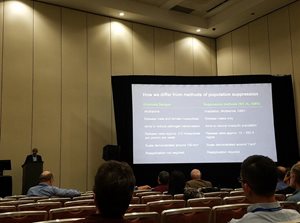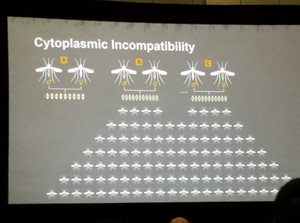 by Mandy Izzo
by Mandy Izzo
Sr Science Writer, Institute for Disease Modeling
Now that I’m a couple of days into ASTMH, I’m starting to realize that one of the most challenging aspects of attending a conference this large is deciding which sessions to attend. There are so many concurrent sessions that no matter what, you are bound to miss something great. The easiest solution is to pick an interesting session and sit through all of the talks within it…however, it can be very tempting to session-hop, and try to attend every specific presentation that catches your fancy. For that, you need to hope that everything runs on time!
Fortunately, there is no choice when it comes to the plenary talk. As a special lecture (and award), there are no concurrent sessions and no need for session hopping! The plenary at ASTMH is the Fred Soper Lecture, named in honor of a prominent American epidemiologist. Fred Soper is best known for his Global Malaria Eradication Program, so it was quite fitting that this year’s honoree and speaker was Dr. Scott O’Neill, an entomologist committed to eradicating arboviruses.
Dr. O’Neill is a Professor at Monash University in Australia and leader of the World Mosquito Program (formerly the Eliminate Dengue Program). His work centers on the use of Wolbachia (a naturally occurring bacteria of insects) to control mosquito-borne diseases. Interestingly, Wolbachia infects over 60% of all insects worldwide, and has been shown to disrupt the ability of pathogens to replicate in their mosquito hosts. Because of this, infecting mosquito species with Wolbachia appears to be a very lucrative method to control transmission of arboviruses such as dengue, chikunguya, or Zika.
Listening to Dr. O’Neill, it is clear why he has dedicated so many years of his career to pursuing this route of transmission control. Mosquito-borne diseases comprise a large portion of burden in global health, and it’s estimated that over half of the world’s population is at risk of dengue alone. The need for sustainable, effective, and safe interventions is quite obvious. So the question becomes: will Wolbachia prove to be the magic bullet to control arboviruses?
There are many reasons to feel optimistic about the use of Wolbachia interventions. Briefly, mosquitoes are reared in the laboratory where they are infected with Wolbachia, and then are released into the wild. Due to cytoplasmic incompatibility, when an infected male mosquito mates with an uninfected female, no eggs are viable (making this a potential method to suppress mosquito populations). However, when an infected male mates with an infected female, or an infected female mates with an uninfected male, all resulting eggs are also infected. Through this, Wolbachia will persist and spread through the population.

An added benefit of this method is that it is safe, both for the environment and for the humans and animals within the environment. It is targeted to mosquitoes, and naturally occurring in the majority of insect species, so there is little risk of unintended harm to non-target species. Research has shown that there is no transmission to other organisms (such as non-target insects, predators, etc).
One aspect of the Wolbachia program that is appealing to me is the potential for citizen science. Very often avenues of research (including the use of interventions) are disconnected from the communities they are meant to help. When the community is not engaged, there is little chance of success but high chance of public distrust in the intervention. However, the World Mosquito Program has spent considerable time engaging the communities they work with, such that households and schools are involved in mosquito-release programs. They can simultaneously educate and engage their volunteers, which in turn provides a larger community in which to conduct intervention programs.
So, the intervention appears to be safe and easy to implement, but is it effective? In the lab, work has demonstrated that Wolbachia infection shows strong blocking of zika viruses in female mosquito salivary glands. Pilot studies are underway over several parts of the world, and initial data is promising. In Townsville, Australia, there is a correlation between mosquito-release programs and a decrease in locally-transmitted dengue. Recent efforts have begun in Brazil and Colombia, and it will be interesting to see if transmission of zika, dengue, or chikungunya decrease. Currently, the answer to the “effective” question seems to be “potentially!”
Sitting in the lecture, it was very easy to get caught up in Dr. O’Neill’s excitement, and to believe that Wolbachia will serve as a solution to the major public health burden of arboviruses. However, as a skeptic and a scientist, I must temper those feelings and wait for more data. As with all monumental claims, there is a mirroring requirement for monumental evidence. Fortunately, the World Mosquito Program appears to be in the process of collecting this evidence; in the meantime, we will simply have to stay tuned and await their results!